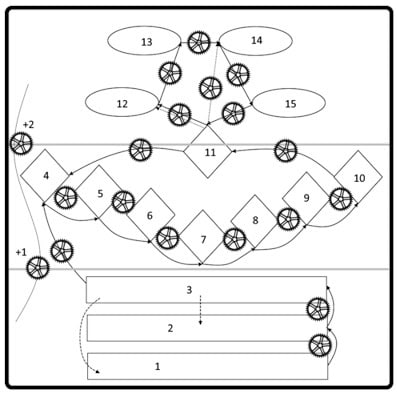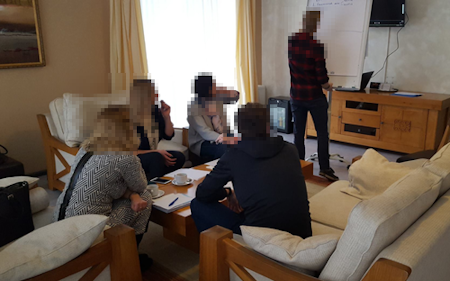HIGH PERFORMANCE TEAM & LEADERSHIP ALGORITHM "HPT 15"
Simply put — you're at point A and need to get to point B. Along the way, there are barriers that must be addressed to reach your objective. The context matters: are you performing well and aiming to excel further, or are you facing challenges that require a turnaround? Either way, bridging the gap between A and B demands more than quick fixes — it requires a well-structured, strategic solution. That’s why, instead of tackling issues in isolation, our programs are built around integrated approaches. We start with a thorough analysis of the current situation, identify root causes, and develop several actionable strategies. Each option is then carefully evaluated and compared to determine the most effective path forward. This process ensures alignment with your organization’s goals, maximizes impact, and supports sustainable development."
WHY HIGH PERFORMANCE TEAM (HPT) & LEADERSHIP?
Only when team members reach a new level of collaboration, they realize how low they had been operating before, and the lower levels no longer hold any appeal. This cannot be explained or described—it must be experienced firsthand.
Building a team capable of achieving high-level performance in a short period is straightforward if the organization has professional individuals with the right attitude, and the team only needs to work closely for a limited time. In reality, organizations must work with the people they have, and collaboration is not a short-term effort but a continuous one. Why HPT? Here are just a few academically proven facts:
Just calculate the KPIs for your sales department to understand where the money is disappearing.
This time, it’s not about an organizational collective or a classic team. What takes center stage is over six years of dedicated work, research analysis, and practical experiments to demonstrate, step by step, how HPT-level teams and leaders operate. Currently, a book is being written on the subject, but while it is still in progress, teams already have the opportunity to learn and implement the necessary algorithm in their daily work.
WHY NOW?
A team either develops itself or stays behind compared to other teams in organizations that are evolving.
In the 21st century, long-term stability is not an option.
We are already on a path where technology and artificial intelligence are gradually “phasing out” the conventional standard team. Whether you want these changes to affect your team or not, they are 200% guaranteed to happen. There are three main reasons for this, which will solidify their position even further in the coming years:
Even if the initial investment is higher, it will pay off in the long run—both financially and psychologically.
Could it be that teams will soon cease to exist? Teams will continue to exist—and at least for another decade or more! This is primarily due to two key reasons:
So, only two types of teams will remain in the future.
1. Teams performing tasks where investment in technology isn’t worthwhile due to low returns. (These environments will not be the most rewarding, and such groups may hardly qualify as true teams.)
2. Teams competing with technology. These teams will need to operate at a High Performance Team (HPT) level to justify their existence and deliver results that make their contributions indispensable.
WHAT ARE THE SOLUTIONS?
Just as the 'HPT 15' algorithm follows a defined structure, all HPT development programs are built on a consistent framework — one that is flexible enough to adapt to a wide range of organizational contexts and end goals.
We frequently receive requests from HR teams asking for training on topics like communication, delegation, or tools to encourage initiative. While these are valuable areas, addressing them in isolation often delivers limited results unless the broader context is taken into account.
In fewer than 25% of cases is the core issue a true lack of knowledge about the topic itself. More often, the root cause lies deeper. For example, you might implement a communication program to improve team dynamics — but what’s really driving the communication breakdown? Is it a matter of skills, or are there other factors at play: lack of motivation, fear, confusion around priorities, or an ineffective information flow?
That’s why, in most situations, our programs are designed and structured as follows:
Of course..., there are exceptions — for example, training for new managers, or cases where analysis clearly reveals that employees lack knowledge in a specific area. In such instances we focus on practical, topic-specific learning.
WHY NAURIS SVIKA?
For a long time, I have been fascinated by exceptional teams capable of achieving more than the average, gray majority. Such teams can be observed in virtually all sectors: politics, business, volunteer organizations, sports, the military, and beyond. More than six years ago, I began deliberately analyzing a wide range of studies on the HPT phenomenon. Based on several of these studies, I conducted small experiments within the framework of my programs. Many insights were also provided by the harsh global events of recent years, which spared no one. Piece by piece, small details were collected to assemble a large mosaic. For those who have moved to level 2 in the game, levels 0 or 1 are no longer of interest.
Initially, it was more of a hobby, compiling a vast amount of information without any particular system.
Exceptions will always exist, and the algorithm will continue to evolve, but it opens the door to an entirely new level of team performance.

















